2003 LEXUS LS430 sensor
[x] Cancel search: sensorPage 2812 of 4500
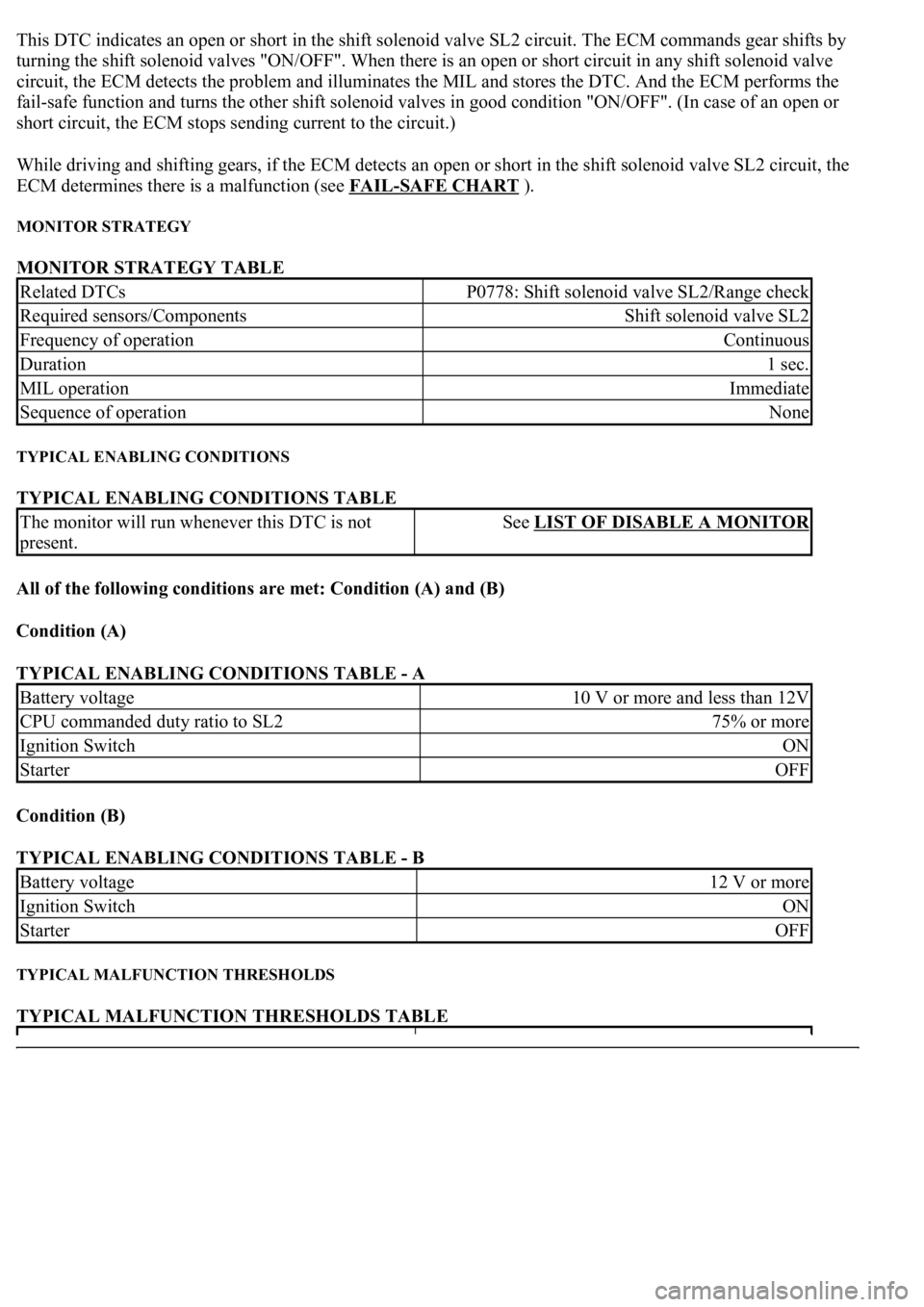
This DTC indicates an open or short in the shift solenoid valve SL2 circuit. The ECM commands gear shifts by
turning the shift solenoid valves "ON/OFF". When there is an open or short circuit in any shift solenoid valve
circuit, the ECM detects the problem and illuminates the MIL and stores the DTC. And the ECM performs the
fail-safe function and turns the other shift solenoid valves in good condition "ON/OFF". (In case of an open or
short circuit, the ECM stops sending current to the circuit.)
While driving and shifting gears, if the ECM detects an open or short in the shift solenoid valve SL2 circuit, the
ECM determines there is a malfunction (see FAIL
-SAFE CHART ).
MONITOR STRATEGY
MONITOR STRATEGY TABLE
TYPICAL ENABLING CONDITIONS
TYPICAL ENABLING CONDITIONS TABLE
All of the following conditions are met: Condition (A) and (B)
Condition (A)
TYPICAL ENABLING CONDITIONS TABLE - A
Condition (B)
TYPICAL ENABLING CONDITIONS TABLE - B
TYPICAL MALFUNCTION THRESHOLDS
TYPICAL MALFUNCTION THRESHOLDS TABLE
Related DTCsP0778: Shift solenoid valve SL2/Range check
Required sensors/ComponentsShift solenoid valve SL2
Frequency of operationContinuous
Duration1 sec.
MIL operationImmediate
Sequence of operationNone
The monitor will run whenever this DTC is not
present.See LIST OF DISABLE A MONITOR
Battery voltage10 V or more and less than 12V
CPU commanded duty ratio to SL275% or more
Ignition SwitchON
StarterOFF
Battery voltage12 V or more
Ignition SwitchON
StarterOFF
Page 2820 of 4500
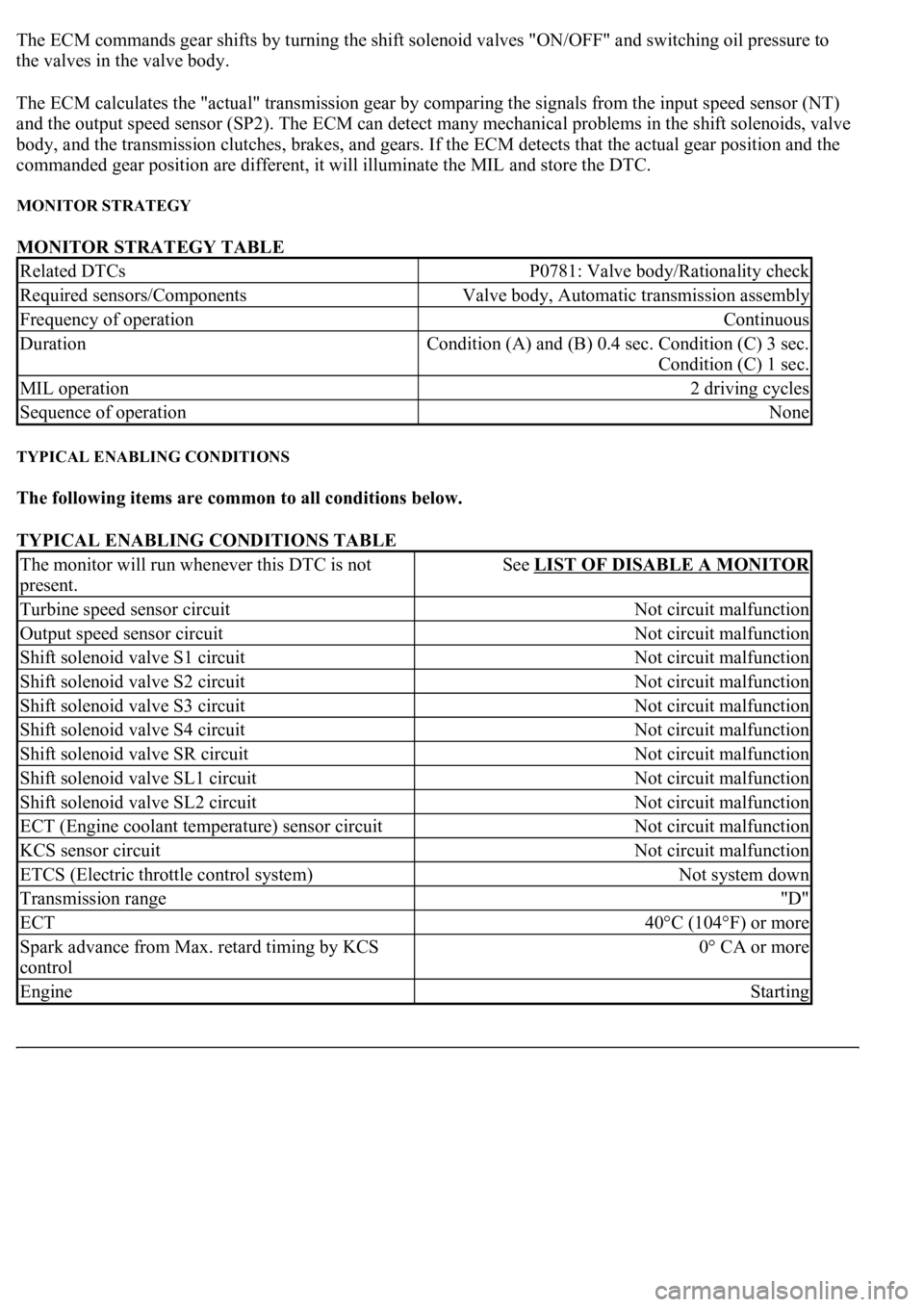
The ECM commands gear shifts by turning the shift solenoid valves "ON/OFF" and switching oil pressure to
the valves in the valve body.
The ECM calculates the "actual" transmission gear by comparing the signals from the input speed sensor (NT)
and the output speed sensor (SP2). The ECM can detect many mechanical problems in the shift solenoids, valve
body, and the transmission clutches, brakes, and gears. If the ECM detects that the actual gear position and the
commanded gear position are different, it will illuminate the MIL and store the DTC.
MONITOR STRATEGY
MONITOR STRATEGY TABLE
TYPICAL ENABLING CONDITIONS
The following items are common to all conditions below.
TYPICAL ENABLING CONDITIONS TABLE
Related DTCsP0781: Valve body/Rationality check
Required sensors/ComponentsValve body, Automatic transmission assembly
Frequency of operationContinuous
Duration<0026005200510047004c0057004c005200510003000b0024000c00030044005100470003000b0025000c00030013001100170003005600480046001100030026005200510047004c0057004c005200510003000b0026000c00030016000300560048004600
110003[
Condition (C) 1 sec.
MIL operation2 driving cycles
Sequence of operationNone
The monitor will run whenever this DTC is not
present.See LIST OF DISABLE A MONITOR
Turbine speed sensor circuitNot circuit malfunction
Output speed sensor circuitNot circuit malfunction
Shift solenoid valve S1 circuitNot circuit malfunction
Shift solenoid valve S2 circuitNot circuit malfunction
Shift solenoid valve S3 circuitNot circuit malfunction
Shift solenoid valve S4 circuitNot circuit malfunction
Shift solenoid valve SR circuitNot circuit malfunction
Shift solenoid valve SL1 circuitNot circuit malfunction
Shift solenoid valve SL2 circuitNot circuit malfunction
ECT (Engine coolant temperature) sensor circuitNot circuit malfunction
KCS sensor circuitNot circuit malfunction
ETCS (Electric throttle control system)Not system down
Transmission range"D"
ECT40°C (104°F) or more
Spark advance from Max. retard timing by KCS
control0° CA or more
EngineStarting
Page 2827 of 4500
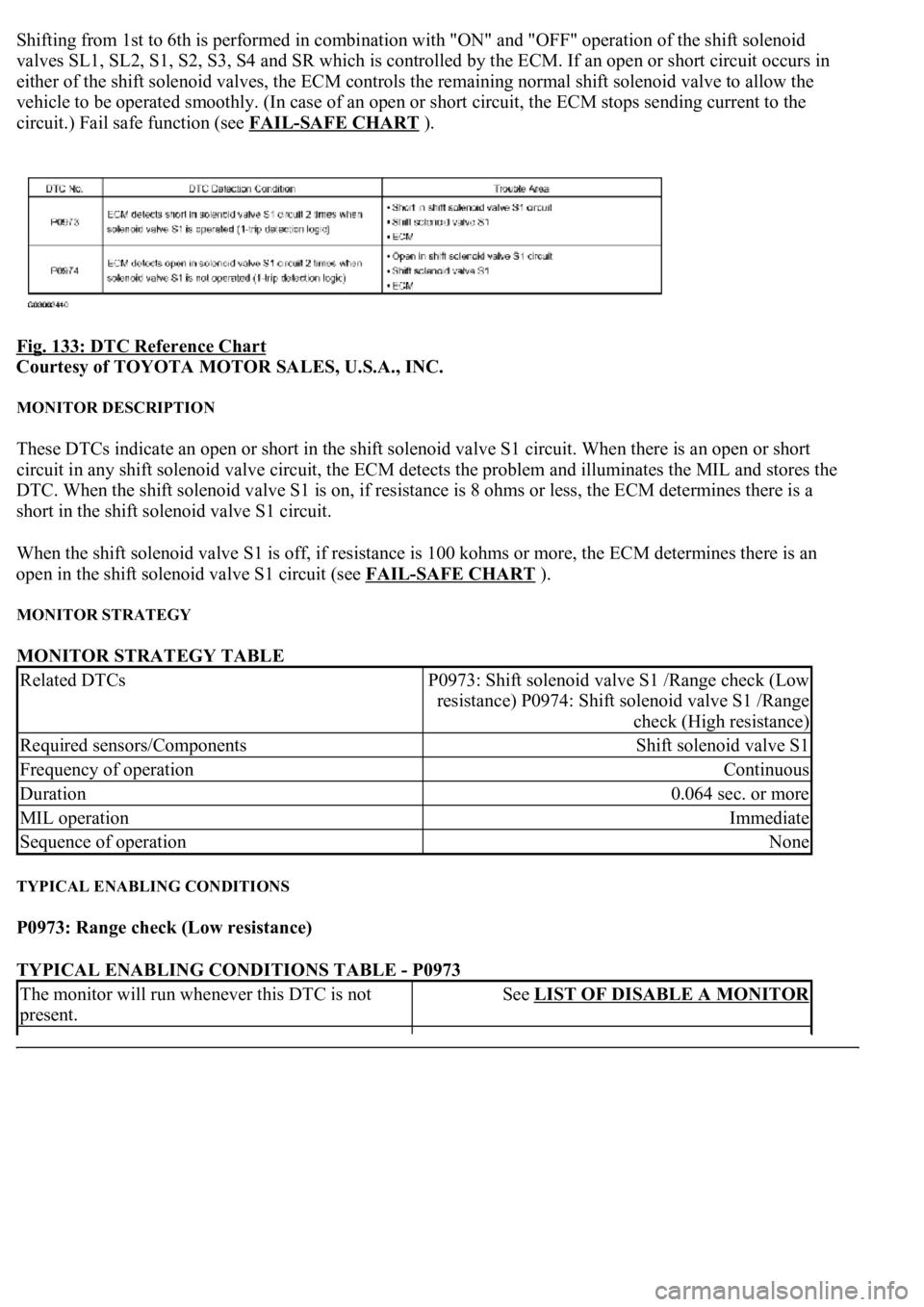
Shifting from 1st to 6th is performed in combination with "ON" and "OFF" operation of the shift solenoid
valves SL1, SL2, S1, S2, S3, S4 and SR which is controlled by the ECM. If an open or short circuit occurs in
either of the shift solenoid valves, the ECM controls the remaining normal shift solenoid valve to allow the
vehicle to be operated smoothly. (In case of an open or short circuit, the ECM stops sending current to the
circuit.) Fail safe function (see FAIL
-SAFE CHART ).
Fig. 133: DTC Reference Chart
Courtesy of TOYOTA MOTOR SALES, U.S.A., INC.
MONITOR DESCRIPTION
These DTCs indicate an open or short in the shift solenoid valve S1 circuit. When there is an open or short
circuit in any shift solenoid valve circuit, the ECM detects the problem and illuminates the MIL and stores the
DTC. When the shift solenoid valve S1 is on, if resistance is 8 ohms or less, the ECM determines there is a
short in the shift solenoid valve S1 circuit.
When the shift solenoid valve S1 is off, if resistance is 100 kohms or more, the ECM determines there is an
open in the shift solenoid valve S1 circuit (see FAIL
-SAFE CHART ).
MONITOR STRATEGY
MONITOR STRATEGY TABLE
TYPICAL ENABLING CONDITIONS
P0973: Range check (Low resistance)
TYPICAL ENABLING CONDITIONS TABLE - P0973
Related DTCsP0973: Shift solenoid valve S1 /Range check (Low
resistance) P0974: Shift solenoid valve S1 /Range
check (High resistance)
Required sensors/ComponentsShift solenoid valve S1
Frequency of operationContinuous
Duration0.064 sec. or more
MIL operationImmediate
Sequence of operationNone
The monitor will run whenever this DTC is not
present.See LIST OF DISABLE A MONITOR
Page 2832 of 4500
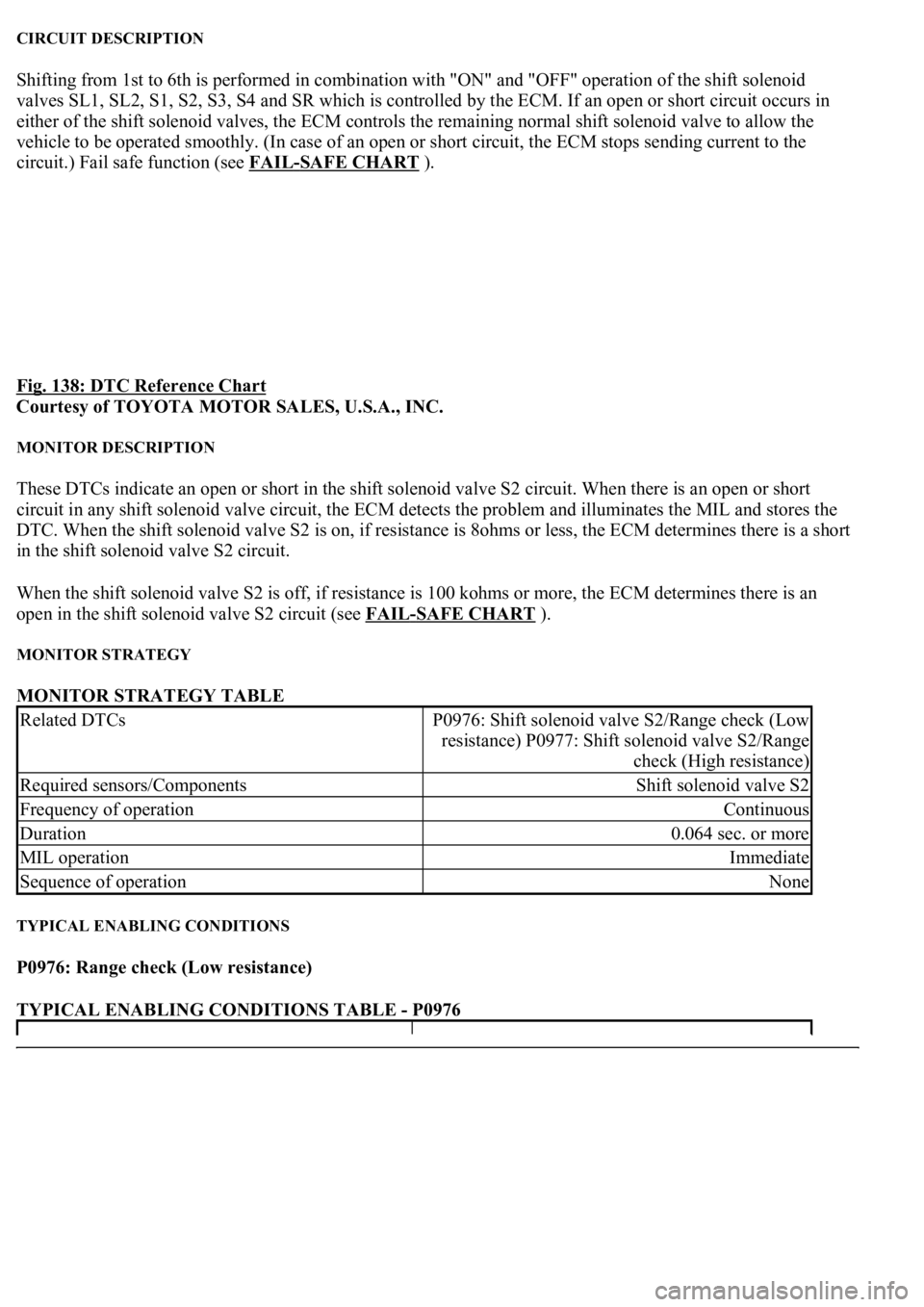
CIRCUIT DESCRIPTION
Shifting from 1st to 6th is performed in combination with "ON" and "OFF" operation of the shift solenoid
valves SL1, SL2, S1, S2, S3, S4 and SR which is controlled by the ECM. If an open or short circuit occurs in
either of the shift solenoid valves, the ECM controls the remaining normal shift solenoid valve to allow the
vehicle to be operated smoothly. (In case of an open or short circuit, the ECM stops sending current to the
circuit.) Fail safe function (see FAIL
-SAFE CHART ).
Fig. 138: DTC Reference Chart
Courtesy of TOYOTA MOTOR SALES, U.S.A., INC.
MONITOR DESCRIPTION
These DTCs indicate an open or short in the shift solenoid valve S2 circuit. When there is an open or short
circuit in any shift solenoid valve circuit, the ECM detects the problem and illuminates the MIL and stores the
DTC. When the shift solenoid valve S2 is on, if resistance is 8ohms or less, the ECM determines there is a short
in the shift solenoid valve S2 circuit.
When the shift solenoid valve S2 is off, if resistance is 100 kohms or more, the ECM determines there is an
open in the shift solenoid valve S2 circuit (see FAIL
-SAFE CHART ).
MONITOR STRATEGY
MONITOR STRATEGY TABLE
TYPICAL ENABLING CONDITIONS
P0976: Range check (Low resistance)
TYPICAL ENABLING CONDITIONS TABLE - P0976
Related DTCsP0976: Shift solenoid valve S2/Range check (Low
resistance) P0977: Shift solenoid valve S2/Range
check (High resistance)
Required sensors/ComponentsShift solenoid valve S2
Frequency of operationContinuous
Duration0.064 sec. or more
MIL operationImmediate
Sequence of operationNone
Page 2837 of 4500
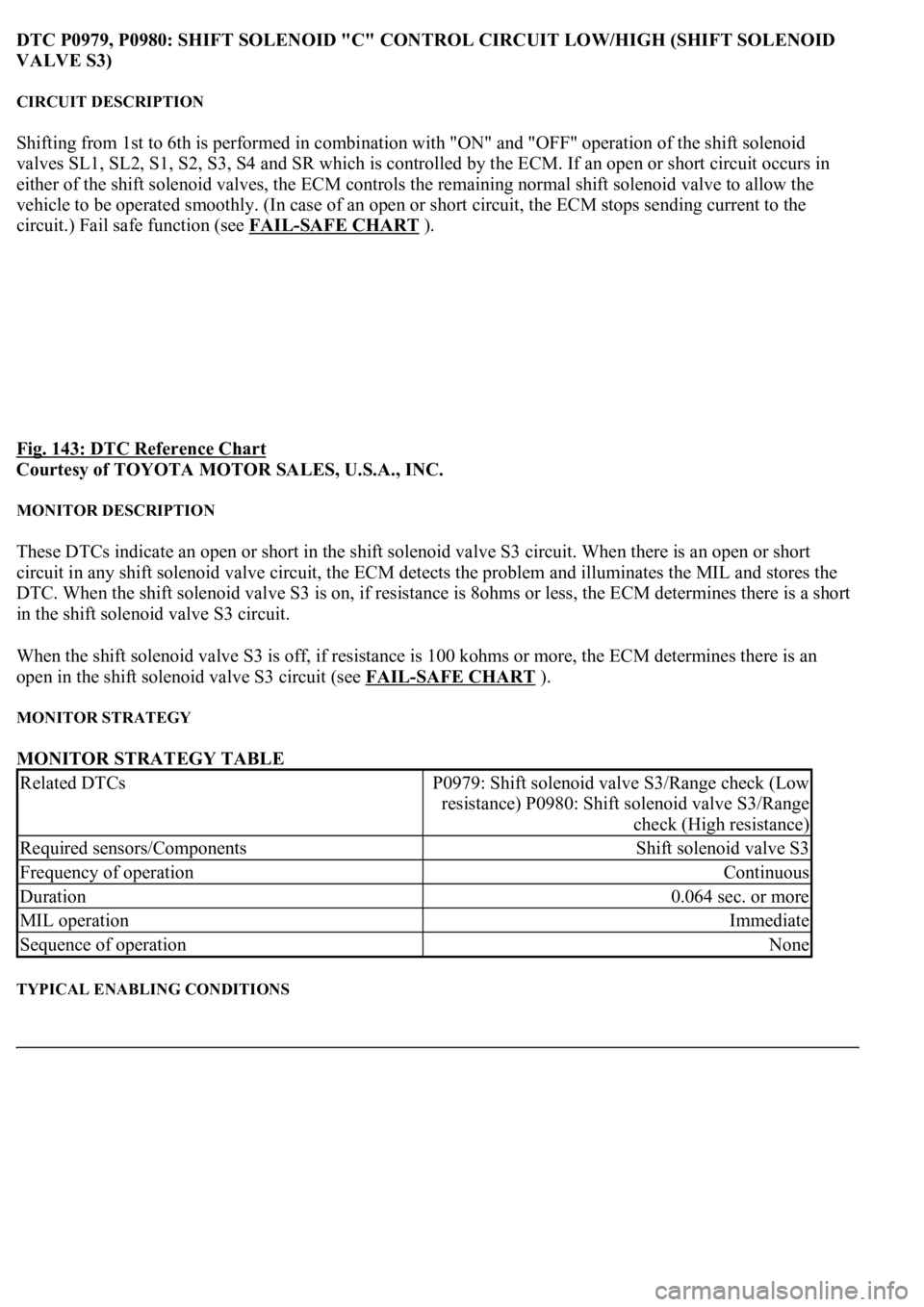
DTC P0979, P0980: SHIFT SOLENOID "C" CONTROL CIRCUIT LOW/HIGH (SHIFT SOLENOID
VALVE S3)
CIRCUIT DESCRIPTION
Shifting from 1st to 6th is performed in combination with "ON" and "OFF" operation of the shift solenoid
valves SL1, SL2, S1, S2, S3, S4 and SR which is controlled by the ECM. If an open or short circuit occurs in
either of the shift solenoid valves, the ECM controls the remaining normal shift solenoid valve to allow the
vehicle to be operated smoothly. (In case of an open or short circuit, the ECM stops sending current to the
circuit.) Fail safe function (see FAIL
-SAFE CHART ).
Fig. 143: DTC Reference Chart
Courtesy of TOYOTA MOTOR SALES, U.S.A., INC.
MONITOR DESCRIPTION
These DTCs indicate an open or short in the shift solenoid valve S3 circuit. When there is an open or short
circuit in any shift solenoid valve circuit, the ECM detects the problem and illuminates the MIL and stores the
DTC. When the shift solenoid valve S3 is on, if resistance is 8ohms or less, the ECM determines there is a short
in the shift solenoid valve S3 circuit.
When the shift solenoid valve S3 is off, if resistance is 100 kohms or more, the ECM determines there is an
open in the shift solenoid valve S3 circuit (see FAIL
-SAFE CHART ).
MONITOR STRATEGY
MONITOR STRATEGY TABLE
TYPICAL ENABLING CONDITIONS
Related DTCsP0979: Shift solenoid valve S3/Range check (Low
resistance) P0980: Shift solenoid valve S3/Range
check (High resistance)
Required sensors/ComponentsShift solenoid valve S3
Frequency of operationContinuous
Duration0.064 sec. or more
MIL operationImmediate
Sequence of operationNone
Page 2843 of 4500
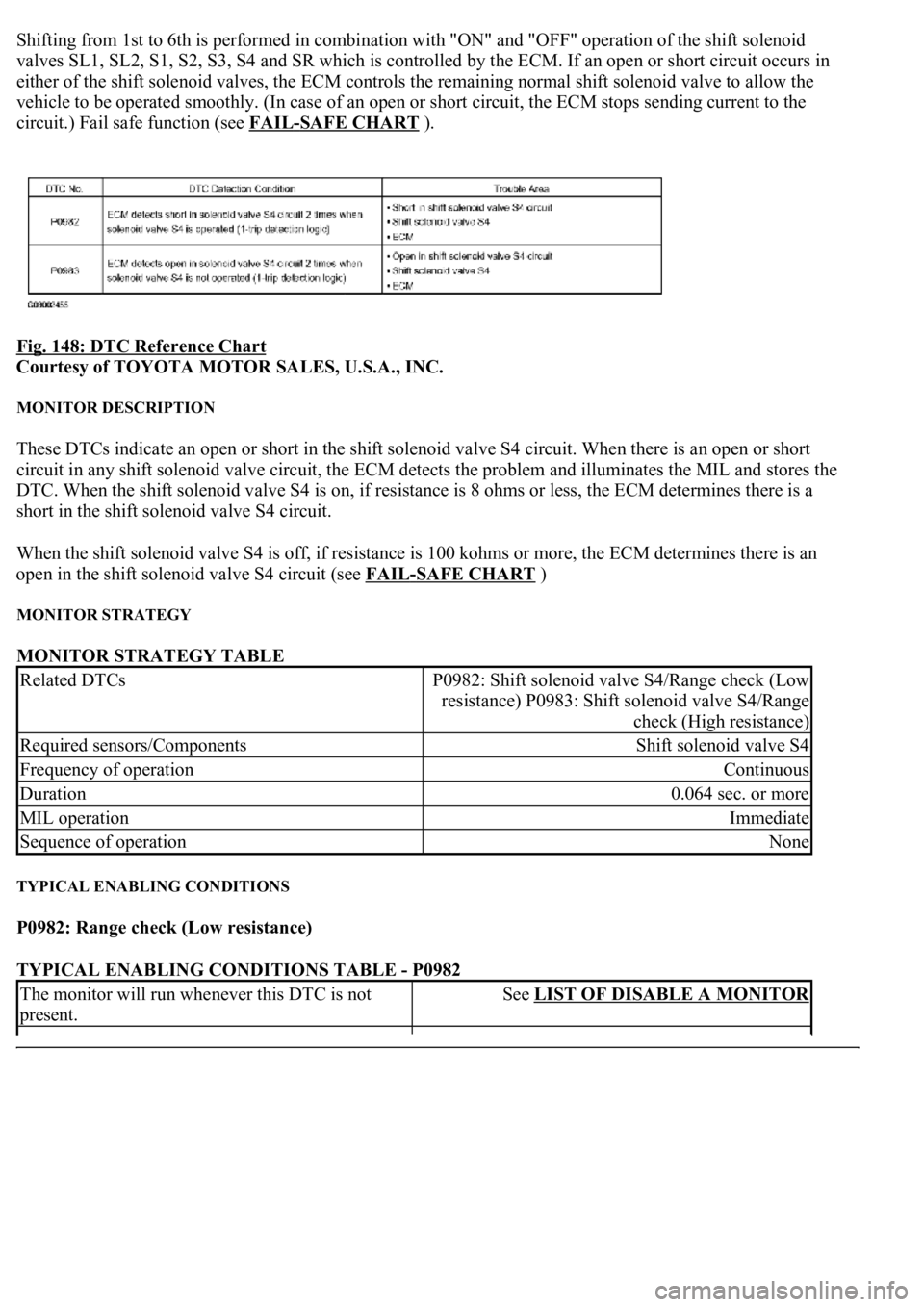
Shifting from 1st to 6th is performed in combination with "ON" and "OFF" operation of the shift solenoid
valves SL1, SL2, S1, S2, S3, S4 and SR which is controlled by the ECM. If an open or short circuit occurs in
either of the shift solenoid valves, the ECM controls the remaining normal shift solenoid valve to allow the
vehicle to be operated smoothly. (In case of an open or short circuit, the ECM stops sending current to the
circuit.) Fail safe function (see FAIL
-SAFE CHART ).
Fig. 148: DTC Reference Chart
Courtesy of TOYOTA MOTOR SALES, U.S.A., INC.
MONITOR DESCRIPTION
These DTCs indicate an open or short in the shift solenoid valve S4 circuit. When there is an open or short
circuit in any shift solenoid valve circuit, the ECM detects the problem and illuminates the MIL and stores the
DTC. When the shift solenoid valve S4 is on, if resistance is 8 ohms or less, the ECM determines there is a
short in the shift solenoid valve S4 circuit.
When the shift solenoid valve S4 is off, if resistance is 100 kohms or more, the ECM determines there is an
open in the shift solenoid valve S4 circuit (see FAIL
-SAFE CHART )
MONITOR STRATEGY
MONITOR STRATEGY TABLE
TYPICAL ENABLING CONDITIONS
P0982: Range check (Low resistance)
TYPICAL ENABLING CONDITIONS TABLE - P0982
Related DTCsP0982: Shift solenoid valve S4/Range check (Low
resistance) P0983: Shift solenoid valve S4/Range
check (High resistance)
Required sensors/ComponentsShift solenoid valve S4
Frequency of operationContinuous
Duration0.064 sec. or more
MIL operationImmediate
Sequence of operationNone
The monitor will run whenever this DTC is not
present.See LIST OF DISABLE A MONITOR
Page 2849 of 4500
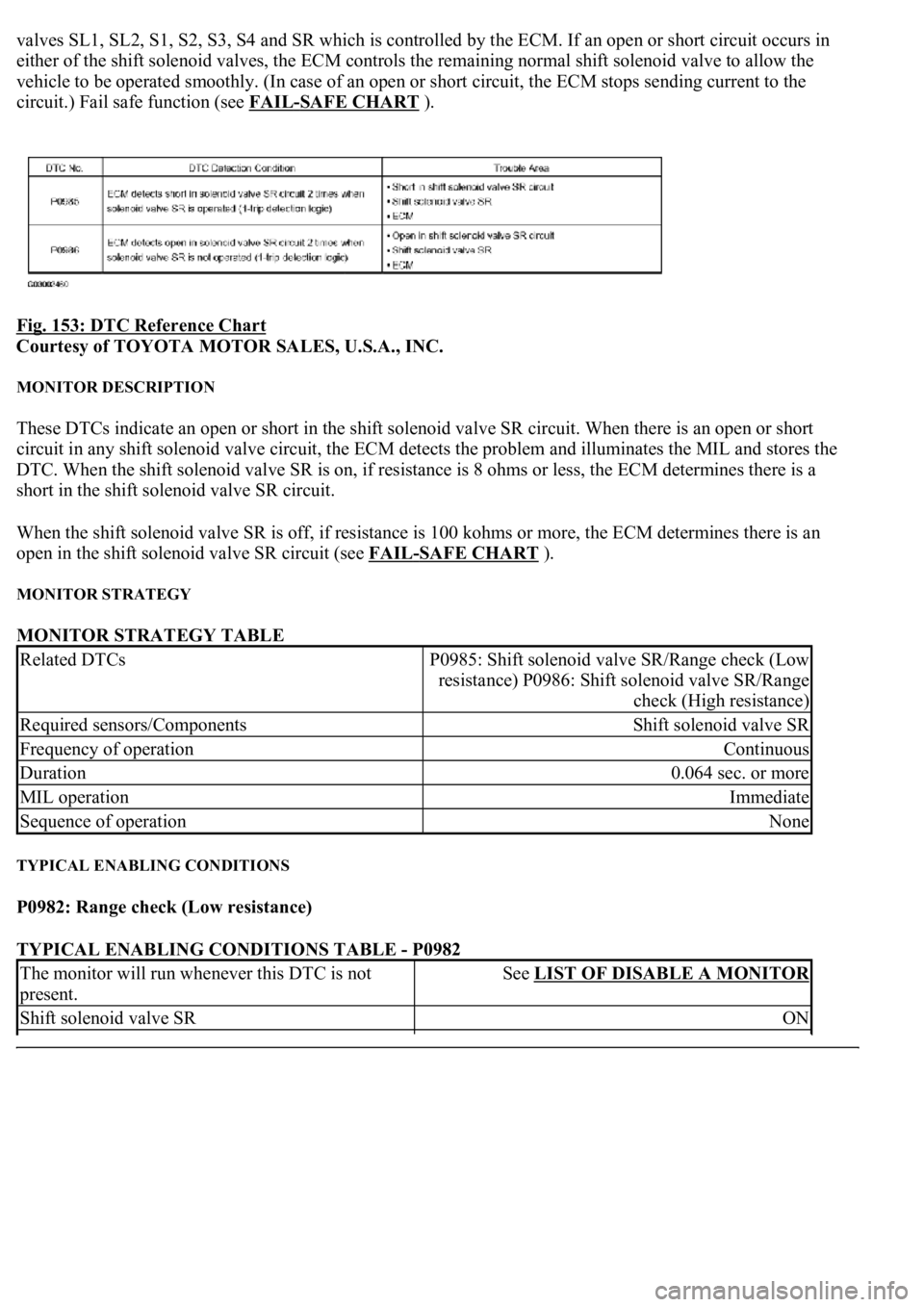
valves SL1, SL2, S1, S2, S3, S4 and SR which is controlled by the ECM. If an open or short circuit occurs in
either of the shift solenoid valves, the ECM controls the remaining normal shift solenoid valve to allow the
vehicle to be operated smoothly. (In case of an open or short circuit, the ECM stops sending current to the
circuit.) Fail safe function (see FAIL
-SAFE CHART ).
Fig. 153: DTC Reference Chart
Courtesy of TOYOTA MOTOR SALES, U.S.A., INC.
MONITOR DESCRIPTION
These DTCs indicate an open or short in the shift solenoid valve SR circuit. When there is an open or short
circuit in any shift solenoid valve circuit, the ECM detects the problem and illuminates the MIL and stores the
DTC. When the shift solenoid valve SR is on, if resistance is 8 ohms or less, the ECM determines there is a
short in the shift solenoid valve SR circuit.
When the shift solenoid valve SR is off, if resistance is 100 kohms or more, the ECM determines there is an
open in the shift solenoid valve SR circuit (see FAIL
-SAFE CHART ).
MONITOR STRATEGY
MONITOR STRATEGY TABLE
TYPICAL ENABLING CONDITIONS
P0982: Range check (Low resistance)
TYPICAL ENABLING CONDITIONS TABLE - P0982
Related DTCsP0985: Shift solenoid valve SR/Range check (Low
resistance) P0986: Shift solenoid valve SR/Range
check (High resistance)
Required sensors/ComponentsShift solenoid valve SR
Frequency of operationContinuous
Duration0.064 sec. or more
MIL operationImmediate
Sequence of operationNone
The monitor will run whenever this DTC is not
present.See LIST OF DISABLE A MONITOR
Shift solenoid valve SRON
Page 2855 of 4500
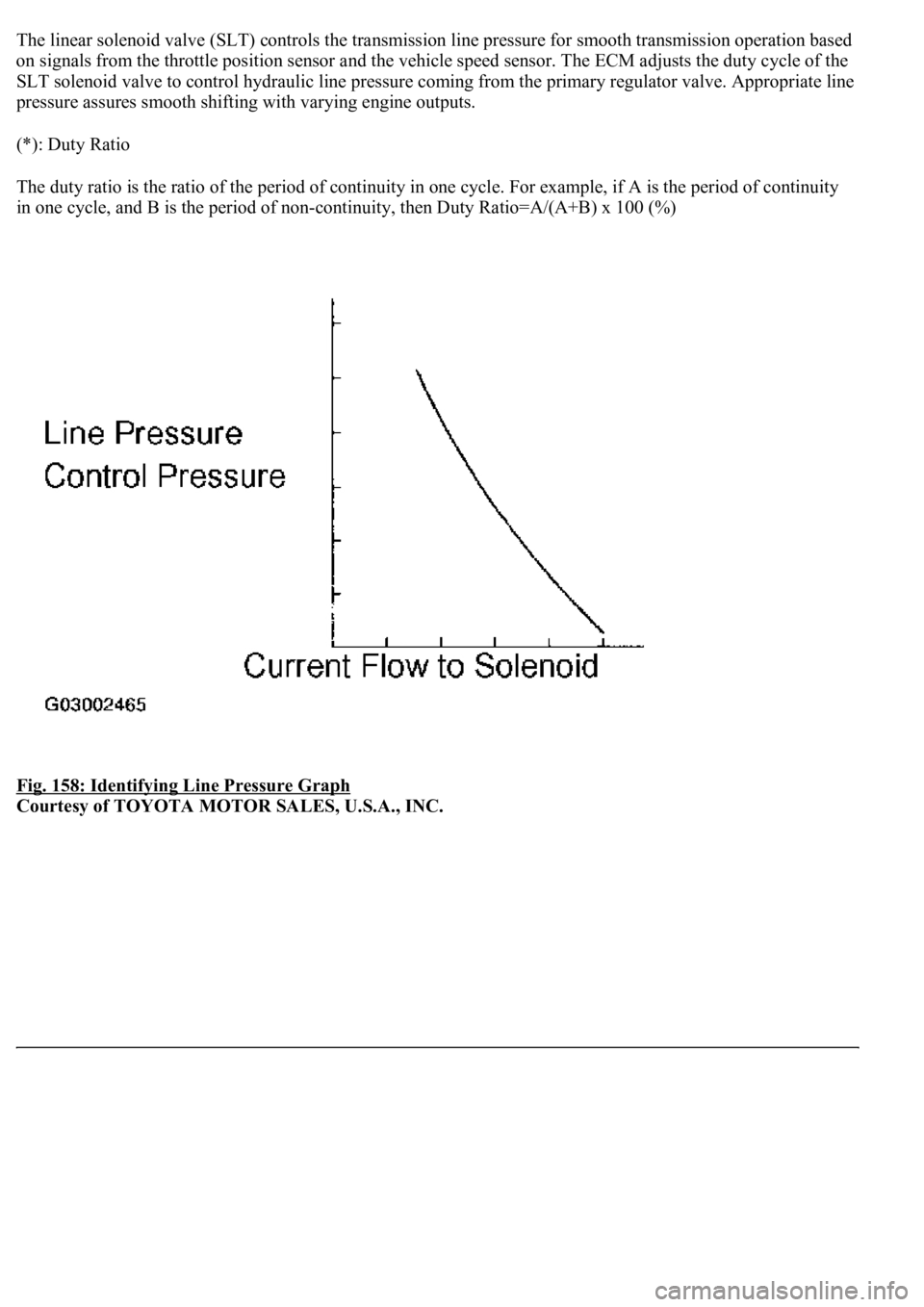
The linear solenoid valve (SLT) controls the transmission line pressure for smooth transmission operation based
on signals from the throttle position sensor and the vehicle speed sensor. The ECM adjusts the duty cycle of the
SLT solenoid valve to control hydraulic line pressure coming from the primary regulator valve. Appropriate line
pressure assures smooth shifting with varying engine outputs.
(*): Duty Ratio
The duty ratio is the ratio of the period of continuity in one cycle. For example, if A is the period of continuity
in one cycle, and B is the period of non-continuity, then Duty Ratio=A/(A+B) x 100 (%)
Fig. 158: Identifying Line Pressure Graph
Courtesy of TOYOTA MOTOR SALES, U.S.A., INC.